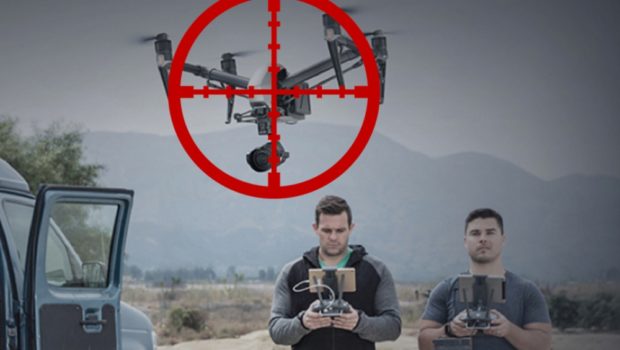Ukraine is asking Chinese drone manufacturer DJI to stop doing business with Russia. Because of how DJI drones work, the company has the technical capability to control where and when its products are flown because of “geofencing” technology it implemented several years ago.
In 2017, DJI, which makes some of the world’s most popular drones, implemented a no-fly zone (for DJI drones) over much of Iraq and Syria, ostensibly because ISIS was jury rigging DJI drones to use in attacks and war there. It did this with a technology called geofencing, in which software embedded in the drone prevents it from taking off or flying in certain geographic areas. DJI’s no-fly zones have also been implemented over specific sensitive areas throughout the world, such as prisons, military bases, and large swaths of Washington, D.C.
According to its own online map, there are very few DJI-restricted flight areas in Ukraine; most of the no-fly zones Motherboard found on its current online map are around airports. Though DJI focuses on making consumer drones, its products are, according to Ukrainian politicians, being used on both sides of the war. The fact that DJI has the ability to restrict flights at all therefore put it in the middle of a conflict that it ostensibly otherwise would have nothing to do with, and require it to at least think about how its technology is being used in the war.
For years, DIY groups and jailbreaking communities have worked to disable any flight restrictions on DJI drones, it perhaps adds intrigue, then, that one of the more popular groups to provide no-fly zone circumvention software and hardware is based in Russia.
In any case, in an open letter to DJI founder Frank Wank posted to Twitter, Ukrainian Vice Prime Minister Mykhailo Fedorov said he believes DJI drones were being used by Russian troops to help missiles navigate to civilian targets, and asked DJI for help making this stop.
“We kindly ask you to provide us with information regarding: 1. The number of functioning DJI products in Ukraine, their ID, where and when they were purchased and activated; 2. The map (on regions of Ukraine) of functioning DJI products in Ukraine; 3: Is there a problem with activating a new DJI product in Ukraine?” Fedorov wrote in his letter.
DJI drones are not, by the strictest definition, military assets. However, a good off-the-shelf quadcopter drone is small and fast and perfect for scouting locations and sighting targets. Consumer drones can also be easily modified to drop grenades and other explosives, something the Islamic State group did frequently.
But Ukraine is accusing DJI of doing much more than providing off-the-shelf drones to the Russian military. Fedorov accuses Russia of using another DJI product, called AeroScope, to identify and target Ukrainian DJI drone pilots with missiles. AeroScope is basically a box that detects, identifies, and geolocates DJI drones:
“AeroScope is a comprehensive drone detection platform that rapidly identifies UAV communication links, gathering information such as flight status, paths, and other information in real-time,” DJI’s website explains. Sold as a safety and compliance feature, DJI claims that AeroScope allows it to see where most commercial drones and operators are on the ground at any given time.
Various drone blogs and Ukrainians on the ground have posted videos in which they say AeroScope is being used by Russia to locate pilots and target them. Motherboard was unable to independently verify if this is what’s happening.
Fedorov stopped short of accusing DJI of backing the Russians in his open letter, but he did ask for DJI to “switch on for Ukrainian users DJI AeroScope function; block all DJI products functioning in Ukraine which were purchased and not activated in Ukraine; block all DJI products which were purchased and activation in the Russian Federation, Syria, and Lebanon.”
DJI responded to Fedorov in a letter of its own on Twitter.
According to DJI, AeroScope can not be turned off. “DJI has not changed the functionality of our AeroScope system in any way in Ukraine, and many Ukrainian AeroScope units are still functioning,” it said. “We do not have the ability to identify and verify a user’s location, and therefore we do not hold the data you have requested.”
DJI did say it could establish a geofenced no-fly zone for its drones in Ukraine, but that it would affect every single drone, not just those operated by Russia. “Please be aware that geofencing is not foolproof, and if the user does not connect to the internet to update the geofence data, the new geofence will not take effect for the drone,” it said in its letter.
Adam Lisberg, DJI’s North American corporate communication director, flatly denied that DJI is extending capabilities to Russians in any way. He also reiterated that DJI was willing to put up a geofence over Ukraine, but that it would affect all its drones in the area, not just those operated by Russia.
“AeroScope technology and geofencing technology were developed by DJI during peacetime,” Lisberg said. “Everything we’ve ever done with our drones we have done in the interest of safety, contemplating their use in peacetime. We never contemplated their features being used in an offensive capacity. We deplore anyone using our drones to cause harm.”
This has all gotten a little bit messy, thrusting a technology company and software and hardware designed for antiterrorism and regulatory purposes into the middle of a disastrous conflict. Brendan Schulman, a former lobbyist for DJI who’s now at Boston Dynamics, tweeted that part of the reason for AeroScope’s entire existence is to make technology that was created for use by hobbyists and professional photographers less enticing as a device for war. None of this changes, however, the fact that these drones can be useful in war, and that DJI now finds itself in a difficult position.
Source: VICE

